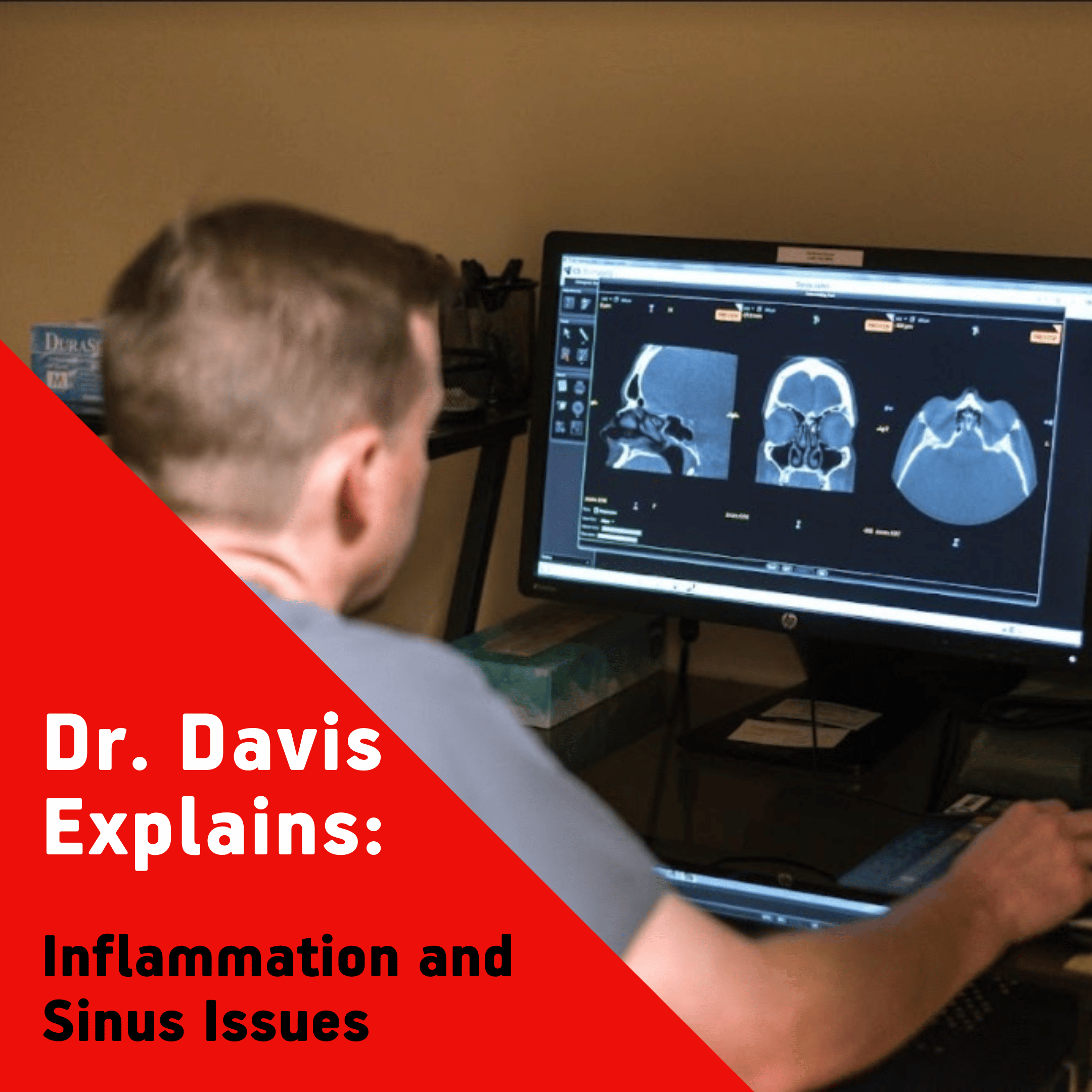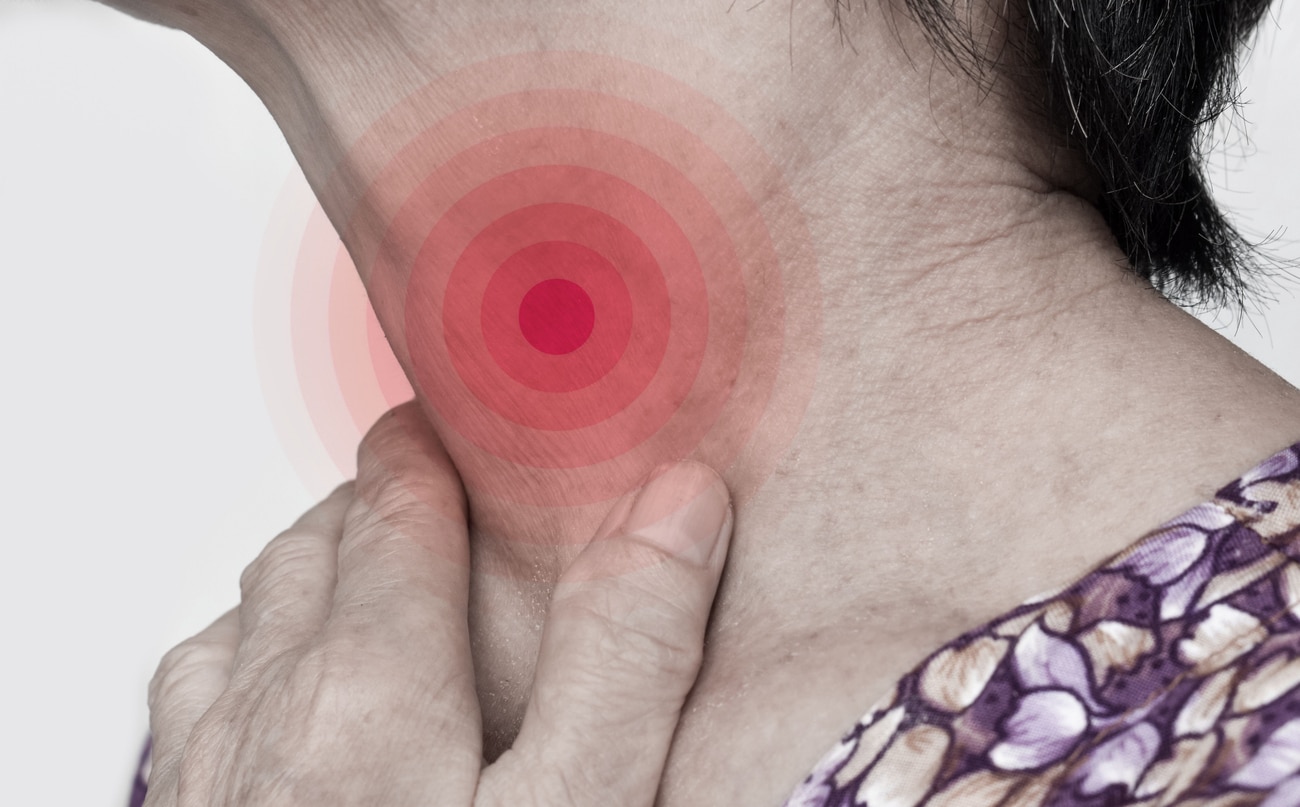Laryngitis is a common condition that affects the voice box or larynx, causing inflammation and…

The Driving Force Behind All Sinus Issues: Inflammation
Many patients often wonder WHY they continue to have sinus problems. What’s the root cause and the driving force behind sinus headaches, drainage, congestion, and pain? The answer is inflammation, and knowing what this means will result in a better overall understanding of your sinus issues.
More About Sinus Inflammation
Chronic sinusitis occurs when the spaces inside your nose and head (sinuses) are swollen and inflamed for three months or longer, despite treatment.
This common condition interferes with the way mucus normally drains and makes your nose stuffy. Breathing through your nose may be difficult, and the area around your eyes might feel swollen or tender.
Chronic sinusitis can be brought on by an infection, by growths in the sinuses (nasal polyps), or by swelling of the lining of your sinuses. Also called chronic rhinosinusitis, the condition can affect both adults and children.
Common signs and symptoms of chronic sinusitis include:
- Nasal inflammation
- Thick, discolored discharge from the nose (runny nose)
- Drainage down the back of the throat (postnasal drainage)
- Blocked or stuffy (congested) nose causing difficulty breathing through your nose
- Pain, tenderness and swelling around your eyes, cheeks, nose, or forehead
- Reduced sense of smell and taste
Other less common signs and symptoms can include:
- Ear pain
- Headache
- Aching in your upper jaw and teeth
- Cough or throat clearing
- Sore throat
- Bad breath
- Fatigue
Chronic sinusitis and acute sinusitis have similar signs and symptoms. However, acute sinusitis is a temporary infection of the sinuses often associated with a cold. The signs and symptoms of a chronic sinusitis last at least 12 weeks, but you may have several episodes of acute sinusitis before developing chronic sinusitis.
Many things can cause inflammation that leads to sinus issues, such as:
- Deviated nasal septum — A crooked septum, the wall between the nostrils, may restrict or block sinus passages, making the symptoms of sinusitis worse.
- Respiratory tract infections — These types of infections are most commonly colds, and they can inflame and thicken your sinus membranes and block mucus drainage. These infections can be viral, bacterial, or fungal.
- Nasal polyps — These are painless, benign growths inside the nasal passages. Prolonged inflammation and swelling of the sinuses from infection and allergies may increase your likelihood of developing polyps.
- Allergies — Inflammation that occurs with allergies can block your sinuses.
- Regular exposure to pollutants — Tobacco smoke and air contaminants can irritate and inflame your lungs and nasal passages.
How Inflammation Causes Sinus Symptoms
Pain in your sinuses — Pain is a common symptom of sinusitis. You have several different sinuses above and below your eyes as well as behind your nose. Any of these can hurt when you have a sinus infection because inflammation and swelling cause your sinuses to ache with a dull pressure. You may feel pain in your forehead, on either side of your nose, in your upper jaws and teeth, or between your eyes. This may lead to a headache.
Nasal discharge — When you have a sinus infection, you may need to blow your nose often because of nasal discharge, which can be cloudy, green, or yellow. This discharge comes from your infected sinuses and drains into your nasal passages. The discharge may also bypass your nose and drain down the back of your throat. You may feel a tickle, an itch, or even a sore throat. This is called postnasal drip, and it may cause you to cough at night when you’re lying down to sleep and in the morning after getting up. It may also cause your voice to sound hoarse.
Nasal congestion — Your inflamed sinuses may also restrict how well you can breathe through your nose. Infections cause swelling in your sinuses and nasal passages. Because of the nasal congestion, you probably won’t be able to smell or taste as well as normal. Your voice may sound “stuffy.”
Sinus headaches — The ongoing pressure, swelling, and inflammation in your sinuses can give you symptoms of a headache. Sinus pain can also give you earaches, dental pain, and pain in your jaws and cheeks. Sinus headaches are often at their worst in the morning because fluids have been collecting all night long. Your headache can also get worse when the barometric pressure of your environment changes suddenly.
Throat irritation and cough — As the discharge from your sinuses drains down the back of your throat, it can cause irritation, especially over a long period of time. This can lead to a persistent and annoying cough that can make sleeping difficult. Sleeping upright or with your head elevated can help reduce the frequency and intensity of your coughing.
Sore throat and hoarse voice — Post nasal drip can leave you with a raw and aching throat. Although it may start as an annoying tickle, it can get worse. If your infection lasts for a few weeks or more, the mucus can irritate and inflame your throat as it drips, resulting in a painful sore throat and hoarse voice.
How to Lessen Inflammation & Improve Sinus Issues
Avoiding things that irritate your nose and sinuses can help decrease sinusitis. While this is not always possible, there are several lifestyle changes and at-home strategies you can try, such as:
- Using a cool-mist humidifier
- Nasal rinsing several times per day
- Wearing a pollen mask when mowing the grass or cleaning the house
- Keeping windows closed when pollen counts are high
- Using HEPA filters in your vacuum
- Changing heating and air conditioning filters often
- Avoiding nasal irritants, such as smoke, perfume, aerosol sprays, smoke, smog, and car exhaust
- Washing bedding often; ideally weekly in hot water
Treatments for Sinus Issues at ExcelENT
If you have had sinusitis several times, and the condition doesn’t respond to treatment; if you have sinusitis symptoms that last more than 10 days; or if your symptoms don’t improve after you see your regular doctor, it’s time to see an ENT specialist, such as Dr. Davis.
He may have new at-home remedies to suggest, and he may feel that there are other treatment options that may be beneficial. Which treatment option may be right for you will vary greatly depending on your specific situation, including what is causing your sinus problems. Here are a few of our treatment options.
Balloon Sinuplasty
This treatment promotes sinus drainage through a minimally invasive technique for mild to moderate chronic and recurrent sinusitis. During the procedure, Dr. Davis threads a small catheter through the sinus opening and inflates a balloon with water. The balloon dilates the sinus opening and widens the outflow tract, which encourages it to drain. The procedure is a quick, non-invasive way to improve drainage, reduce the potential for bacterial infections, and improve breathing. Numerous studies have shown that 90 to 95% of balloon sinuplasty patients benefit from the procedure for at least two years.
Functional Endoscopic Sinus Surgery
This is a procedure we use to treat moderate to severe sinus problems. If you’re no longer responding to treatments like nasal irrigation, antibiotics, and decongestants, you may be a good candidate. During the procedure, Dr. Davis uses an endoscope to locate and remove bone and tissue in the sinuses that are preventing drainage. Sinus surgery creates larger drainage pathways to reduce the chances of mucus buildup after recovery. General anesthesia is often required for the procedure, which usually takes between one and three hours. Recovery is typically quick, with very little pain.
SINUVA
This is an innovative treatment for nasal polyps. For many people, nasal polyps are a chronic problem that persists throughout their lives with symptoms such as runny nose, congestion, sinus pressure, postnasal drip, snoring, headaches, and more.
SINUVA is a non-invasive nasal implant that delivers an anti-inflammatory corticosteroid (mometasone furoate) directly to the polyps. Dr. Davis can place the SINUVA implant in the office if you have had previous endoscopic sinus surgery. The implant stays in place for approximately 90 days, after which he will remove it. SINUVA successfully reduces polyp inflammation without surgical intervention.
VIVAER Nasal Airway Remodeling
The VIVAER treatment, performed in our office, is a non-invasive procedure that involves no cutting. Your nasal valve area is gently and permanently reshaped using low-temperature radiofrequency energy. Immediately after treatment, you’ll begin to experience a noticeable improvement in nasal breathing.
Septoplasty
The nasal septum is the wall between the nostrils that separates the two nasal passages, and problems in this area can make breathing difficult. Surgery to straighten the septum is called a septoplasty, or deviated septum surgery.
The procedure usually takes 60 to 90 minutes and is performed in an outpatient surgery center. Before the surgery, we look at your nasal passages and view the shape of your septum. Dr. Davis then uses surgical tools to enter the nostrils and straighten the septum.
Dupixent
Dupixent is a new biologic option to treat and manage sinus conditions for those who may have been candidates for sinus surgery in the past. It is a game-changer for managing sinus disease!
Dupixent is a treatment used with other medicines to treat chronic rhinosinusitis with nasal polyposis in adults to reduce the size of nasal polyps, improve congestion, improve loss of smell, and reduce the need for surgery.


